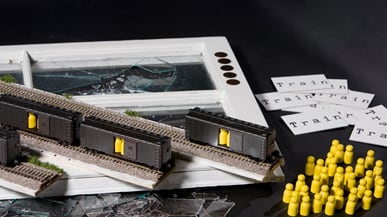These days, videogames are generally judged by their technical sophistication, and so it was unusual last week when an Israeli programmer made news by unveiling a game that was outmoded in everything except its subject. Sonderkommando Revolt was pure 1992 in its graphics and its gameplay, but it violated one of the gaming industry’s few taboos: It took place in Auschwitz.

“The Holocaust should be off-limits for videogames,” the Anti-Defamation League told the gaming site Kotaku—and Sonderkommando Revolt makes it hard to disagree. Its creators say they intend the game as nothing more than “blast-the-Nazis fun.” How then does one interpret the game’s video preview, where the violence includes not one but two instances of a guard dog tugging at the bleeding body of a prisoner, presumably a Jew?
Despite the controversy, Sonderkommando Revolt is not, in fact, the first time a game designer has taken on the Holocaust. Earlier this year, when Roger Ebert declared that “ videogames can never be art,” some gamers sought to change his mind by suggesting he check out Train by game designer Brenda Brathwaite, one of the industry’s trailblazing women.
When Rob was the first to move a boxcar to the end of the line, he followed the rules and drew a Terminus card. Train’s subject was no longer hidden. The card said “Dachau.”
Train shares almost nothing in common with Sonderkommando Revolt besides its subject. For starters, it’s not a videogame. It unfolds atop a shattered window. Three model train tracks run diagonally across the broken glass. Game pieces include two stacks of cards, a black typewriter holding the rules, 60 yellow wooden pawns, and six gray model boxcars.
Each turn, players can roll a die and choose to advance their boxcar or load it with pawns; alternatively, they can use a card to speed or slow a boxcar’s progress. Brathwaite’s goal, she says, was to make a game about complicity, and so the rules drop the player not in the shoes of a Holocaust victim but a train conductor who helped make the Nazi system run.
In November, I watched three college students play Train at the Euphrat Museum of Art in Cupertino, California. As the game began, a man wandered over and looked at the pawns. “Are those people?” he asked, “in boxcars?”
“They’re traveling first-class,” a student named Jon replied.
At that point, Train had not formally revealed its subject, and Jon and the others played as though it were a normal board game, trying to outrace each other. When Rob was the first to move a boxcar to the end of the line, he followed the rules and drew a Terminus card. Train’s theme was no longer hidden. The card said “Dachau.”
Before Brathwaite became known as the woman who made a game about the Holocaust, she designed videogames for nearly 30 years. She got her first job in 1981, at the age of 15, answering a tip line for frustrated players of Sir-Tech’s foundational first title, Wizardry. By the time the series concluded with Wizardry 8 in 2001, Brathwaite was the lead designer.
After Sir-Tech closed that same year, she went on to design games including Playboy: The Mansion, in which gamers assume the role of Hugh Hefner and try to rebuild his empire. Her professional videogame experience helps explain why gamers recommended Train to Ebert, even though it wasn’t a videogame. Brathwaite is perhaps the first major designer to cross over from the commercial-gaming industry to the “art games” movement—and to bring the attention of so-called hardcore gamers with her. “Not many people can bridge the gap between the game industry and the critical world and the creative world, and Brenda can do that very well,” says game designer Mary Flanagan.
Train is the third title in a series of six non-digital games she calls “The Mechanic Is The Message.” The series was sprung one afternoon in 2007, when her daughter Maezza followed a thoughtless rehash of the day’s school lesson about the Middle Passage by asking to play a game. Brathwaite invented a game on the spot. She had Maezza spend half an hour painting wooden pawns and grouping them into families. Brathwaite then scooped the pawns at random, placed them on an index card, and explained the rules: You have 10 turns to cross the ocean and 30 units of food; each turn you must roll the die and use that much food. After a series of high rolls, Maezza looked to her mother: “Mommy, we’re not going to make it.”
Afterwards, Maezza cried as she asked for the first time about the family history of her father, who is part black. Summarizing the experience at the Game Developers Conference this year, Brathwaite said, “All these amazing questions that came about not because she saw a movie, not because she got a poster, not because she got some dumb interactive lecture, but because she made characters. She spent half an hour with those characters, and those characters mattered to her, and those characters’ lives were affected by a Middle Passage that happened on an index card.”
At that time, Brathwaite was teaching at the Savannah College of Art and Design, which freed her from the constraints of commercial game design, and she decided to make games about five more “difficult” subjects: Cromwell’s conquest of Ireland, the Holocaust, the Trail of Tears, illegal immigration, and Haitian poverty. Her goal was more than “blast-the-Nazis fun.” “I wanted to do a design exercise to see if you could use game mechanics to express difficult subjects,” Braithwaite says. “Every single atrocity, every single migration of people—there was a system behind it. If you can find that system, you can make a game about it. All games are, is systems.”
“The work Brenda is doing gives me hope that games can be more than just widgets of fun,” says John Sharp, Brathwaite’s former colleague at SCAD. So far, Brathwaite has completed the first three games, with the next three in various stages of prototype. She has no plans for commercial production, which would be impossible anyway given their designs: Síochán Leat is built atop a burlap sack filled with personal mementos; Train’s rules are written on a Nazi typewriter; and the Trail of Tears game will have 50,000 pieces when it’s done.
Train has proven the most controversial, particularly because of Brathwaite’s decision to formally conceal the subject until late in the game. Critics say it’s a bait and switch. “If, following a game of chess, I declare all the white pieces were homosexuals, should the black player experience any guilt for their participation in systematic homophobia?” asks Stewart Woods, a board-game scholar at Australia’s Curtin University of Technology.
But the surprise some players experience at discovering the game’s subject may result more from their own ignorance than an intentional trick in Brathwaite’s design. “There’s nothing about this game that doesn’t scream, ‘I’m about the Holocaust,’” Brathwaite says, and she has a point: The game’s symbolism—from the broken window to the boxcars to the yellow pawns—isn’t exactly concealed.
Nor is the game necessarily finished when the subject is revealed. “Train is over when it ends,” according to the rules. After drawing the first Terminus, players can continue sending pawns to the camps.
That’s exactly what happened in Cupertino. Upon reaching the end of the line, Rob emptied his boxcar and placed 10 yellow pawns on the Dachau card. On his next turn, Rob moved a second boxcar to the end of the line, took a new card, and arranged four yellow pawns around the word “Chelmno.”
Earlier, Brathwaite had said no players had ever moved all 60 pawns to the camps. But at one point in Cupertino, all but five pawns were on a card or in a boxcar. When Helen drew her first Terminus card, she showed it to Jon, who said, “Bergen-Belsen, nice! It’s so fun to say.”
Typically, players of Train consulted the rules and tried to find ways to undermine them. “I used the concept of rules lawyering as a mechanic in the game,” Brathwaite explains. “It’s important that players are making the decisions and talking about the decisions, because I want them to feel complicity. I want them to feel some responsibility.” Though Train appears to be a rather simple “race to the end” game, Brathwaite insists it was the hardest rule-set she’s written. “With every word I wrote, I was closing off a possibility. With every word I didn’t write, I was allowing freedom.”
In Cupertino, Brathwaite was dismayed. “They’re playing it as it literally can be played,” she marveled. “I do not want this to happen. Do I interfere?”
She approached the players. “Do you know you can use the rules to save them?” she asked.
Shortly after, Jon, who turned out to have known the game’s theme the entire time, quit. “I don’t think I’m comfortable being the first person to complete Train,” he said. Rob then followed, telling Helen, “You can be the queen of bringing people to concentration camps.” Helen said, “I win.”
“The fact that players are objectifying wooden pawns is not surprising,” says Woods. “They are, after all, objects.” But Train’s dynamics continued to develop, even after the players left the pawns behind. “You wanted to win,” Rob said to Helen. “Well, you killed the most,” Helen shot back.
Previous players had exploited gaps in the rules to thwart all movement toward the camps. One former player simply declared that the Allies had landed—an intervention that, in real life, would have saved millions of lives. But even as Train permits such historical flights of fancy, it remains aware of the larger rules that govern how it’s played. Before starting the game, Brathwaite invites the participants to shatter the window panes of the game board—an act that requires them to rebel against the respect with which they’re taught to treat a work of art. Of the hundreds of people to play Train, only one has ever broken the glass.
Ben Crair is the deputy news editor of The Daily Beast.






